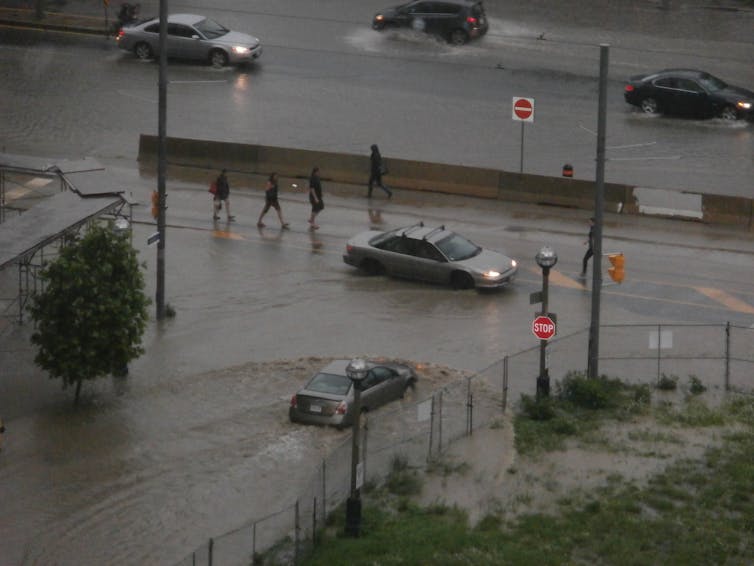Wild weather seems increasingly widespread these days. Cities are especially vulnerable to extreme weather, meaning that many of us will end up paying for the damage it can cause.

But how much we pay — and when — is largely up to us. We could, for example, pay now to prepare ourselves and limit future damage, or we can pay later to repair our properties and restore the environment.
Urban flooding — and other complex, environmental challenges — can be solved when communities work together to share their experiences and knowledge. In Canada, the Faculty of Environment at the University of Waterloo is taking the lead on this as part of the UN Sustainable Development Solutions Network.

WATCH ABOVE: Barnston Island, B.C. prepares for flood
Urban floods on the rise
Many factors contribute to the increasing risk of flooding in urban areas. For one, in many regions, climate change seems to be causing more intense downpours than what have occurred in the past.
This is a problem because the storm-water systems built just a generation ago were not designed to handle the amounts of rain we are seeing now — and expecting in the future.
The growth of cities also contributes to urban flood risk. The increased construction of hard, sealed surfaces hinders rain from soaking into the soil and causes runoff. If there is too much runoff, the water pools and enters our lakes and rivers, dragging oil, metals, road salt or pesticides with it.
Or it can turn into a flood.

The density of sealed ground continues to grow in urban areas. We just keep on adding more houses, more roads, more parking lots. From 1991 to 2011, the built-up urban area in major Canadian cities increased by more than 20 per cent.
On top of that, houses are being built closer together and they get ever bigger. More than half of the homes built after 2001 are larger than 140 square metres. When you factor in that these new homes come with patios, parking pads, driveways and sidewalks, it’s no wonder we have a problem.
Level of preparedness
- What is a halal mortgage? How interest-free home financing works in Canada
- Capital gains changes are ‘really fair,’ Freeland says, as doctors cry foul
- Ontario doctors offer solutions to help address shortage of family physicians
- Budget 2024 failed to spark ‘political reboot’ for Liberals, polling suggests
Unfortunately, city dwellers, by and large, are not well-prepared for urban floods. A recent study found that most people do not know if they are living in flood-prone areas and, if they do, many do not take measures to protect themselves against flooding.
They may not know that many home insurance policies do not cover water damage from flooding, but only damage from broken pipes or similar issues. Or if the policies do cover flood damage, that the coverage might be limited.
And governments may refuse to bail house owners out, so to speak, if they could have purchased insurance add-ons that do cover flood damage.
Even so, most municipalities do not address the issue of urban floods as effectively as they could — maybe because their budgets are too strained to act or they have other, seemingly more pressing, priorities.
Recently, flooded-out residents in Ontario have filed lawsuits against their municipalities, and a few years ago in Illinois, a major insurance company filed nine class action lawsuits against municipalities over this.

WATCH ABOVE: How these Quebec residents are coping one year after a flood
How can homeowners prepare?
It is not a question of whether wild weather will affect your neighbourhood, but when. Somebody will pay for it — and it might be you.
You could pay upfront to protect yourself against damage or afterwards to fix it. There are a number of things that people can do to protect their homes, their neighbourhoods and the environment against the damages caused by urban floods:
- Purchase add-on flood protection with your home insurance.
- Keep the water from getting in. Covers can prevent water from rushing in through basement window wells, and foundation grading can direct surface water away from your house. You could also install a sump pump or sewer backflow prevention system.
- Install on-site water storage to collect and store rainwater for safe release later. Some municipalities sell rain barrels; larger water storage tanks are even better.
- Green infrastructure solutions can slow down rainwater runoff and help the ground soak up the water. Rain gardens — specifically designed depressions with plants for increased water infiltration — and green roofs are options. Patios and driveways can be built with permeable pavements.
- Talk to your neighbours, your neighbourhood association and your city councillor about urban floods. These strategies work best when many people in a neighbourhood take action together.
Change can be expensive, but municipalities are increasingly providing tax incentives or financial assistance to pay for some of them.

Nothing will provide 100 per cent protection against the potential losses from urban floods, but planning ahead reduces the odds that you will be flooded and may reduce your costs when a flood does occur.
Michael Drescher, Associate Professor, University of Waterloo
This article was originally published on The Conversation. Read the original article.



Comments